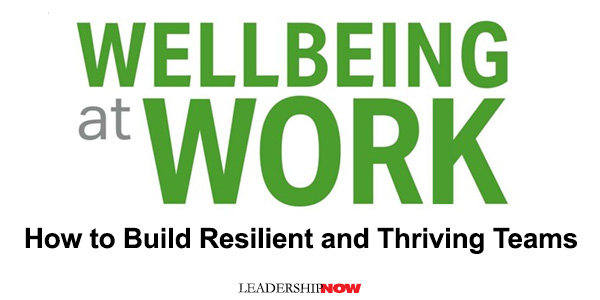 |
 |
06.18.21

Wellbeing at Work
WHAT DOES it take to thrive? It seems to be an elusive goal. Gallup research has found that about seven in 10 people are struggling or suffering in their lives. In Wellbeing at Work, Jim Clifton and Jim Harter report that beginning in the late 1950s, Gallup sought to discover and quantify the difference between the best possible life and the worst possible life. Currently (2021), “Gallup has found that 17% of the world’s population is suffering (worst life), 59% is struggling, and 25% is thriving (best Life).” So, what does this mean to leaders? People bring the whole person to work. “Work should be a stabilizing force in people’s lives. And employers play a central role in shaping the whole person.” People who are not “thriving in their lives are much more vulnerable and add risk to your organization.” 61% higher likelihood of burnout often or always
If you follow this blog, it is obvious to you that this impacts relationship, creativity and innovation, energy, and trust. From the Gallup global surveys of wellbeing, there emerged five essential elements of wellbeing that differentiate a thriving life from a suffering or struggling life. These are all aspects of your life that you can do something about. Interestingly, Gallup found that the most important element is career wellbeing. Thriving is having a positive view of your life in each of these five areas. Career Wellbeing: You Like What You Do Every Day “My job and my manager are the two strongest links to net thriving.” Many find spending time with their manager to be the worst time of their day. We can fix that by improving employee experiences and teaching managers to be better coaches. What can leaders do?
Social Wellbeing: You Have Meaningful Friendships in Your Life Social time builds friendships. Friendships mitigate division, bias, gossip, and office politics. Gallup found that “almost all forms of social time boost mood, but technological remote forms such as texting and social media have thresholds—mood drops after moderate amounts. While both remote and in-person socializing is beneficial, in-person interaction has the greatest impact on mood. But that doesn’t mean you have to overdo it or that social connections have to drain time to be effective. Create regular opportunities for people to get to know one another through work.” Financial Wellbeing: You Manage Your Money Well Almost half of Americans live paycheck to paycheck. Money may not buy happiness but properly managed, it creates more opportunities and freedom. Raises in income affect happiness to a point. “Above an annual income of 90,000 on average, daily emotions do not improve with increases in income.” Leaders can help by providing financial planning, investing, and savings resources and tools. Physical Wellbeing: You Have Energy to Get Things Done “Your organization’s ability to bounce back from a public health crisis, or any crisis, depends on how resilient your employees are.” So, encouraging healthy choices is a win/win. We have the most control over sleep, exercise, and diet. All three can improve our immunity and mood. Community Wellbeing: You Like Where You Live Communities help people know that their lives matter outside of work too. “No matter how digital society has become, people still live in physical places that form the foundation of their social lives.” Not just being a part of something but caring for others fights against stress and negative emotions. Like the other four wellbeing elements, community wellbeing feeds, and is fed by, the other elements of wellbeing. Those with high community wellbeing have active lives, are more likely to be engaged at work, and have more frequent social interactions. In the same way, physical health and financial security make giving and volunteering possible. While career wellbeing is foundational to the other four elements, it is important that they are all in balance. “All things being equal, thriving in what you do every day makes for stronger relationships, a more secure financial life, good health, and greater community involvement.” If you are on the low end of the scale on any one or more of the elements, then that’s where you need to start to move toward thriving. The elements are all interrelated, so focusing on just one area will cause you to fail overall. “Those who had an imbalance in points across the elements had the lowest wellbeing—in particular when they gave an overabundance to financial wellbeing.” If you want to build a thriving culture, you need to avoid the four risks:
People need, especially in a crisis, four leadership traits as a signal that their life will be OK: Hope (Is there a clear plan for the future?), Stability (Am I well-prepared to do my work?), Trust (Does my manager keep me informed?), and Compassion (Does my organization care about my wellbeing?). These help to build a net thriving and resilient culture. The authors dig deeper into implementing wellbeing practices. As knowing your employee strengths “is the first step to having the most individualized, positive and effective wellbeing conversation with them,” they have included an appendix that ties in with the CliftonStrengths profiles. A very useful tool, along with the condensed action guide you will also find in the appendix. 
Posted by Michael McKinney at 08:24 AM
|
BUILD YOUR KNOWLEDGE
 

How to Do Your Start-Up Right STRAIGHT TALK FOR START-UPS 
Grow Your Leadership Skills NEW AND UPCOMING LEADERSHIP BOOKS 
Leadership Minute BITE-SIZE CONCEPTS YOU CAN CHEW ON 
Classic Leadership Books BOOKS TO READ BEFORE YOU LEAD |